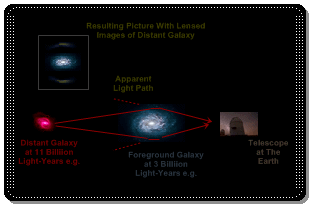
| CONTENT - What gravitational lensing is |
A cosmic magnifying lens occurs when a massive celestial object like a galaxy or cluster of galaxies is interposing itself between the objet whence the light is coming from -most usually a distant galaxy- and a observer. As the light rays are bent through the mass of the intervening object, the observer is seeing -or photographying- two, or more, distorted images of the distant galaxy. Light further, is amplified. Light is curved through mass according to Einstein's Theory of Relativity and Einstein self had predicted about 1936 the existence of gravitational lenses. It was not until in the 1980's however that the first observation of one occurred. It wasn’t until 1936 that a Swiss astronomer named Fritz Zwicky realized the potential of gravitational lensing as a tool to study the Universe beyond our stellar neighborhood. When calculating the masses of clusters of galaxies Zwicky noted that there was a good chance more distant galaxies located behind them would have their light deflected as it passed these clusters. For almost 50 years, Zwicky's suggestion received little attention. The potential lensed galaxies were, after all, far too faint to be seen. That changed in the 1980s, when the development of the first digital imaging devices replaced photographic plates and dramatically increased the sensitivity of telescopes to faint sources. The first object seen through the technique was in 1986, a extended arc discovered in galaxy cluster Abell 370, a spiral galaxy located at twice as far away as the cluster itself. Galaxy lensing also changed by 1996 the record-holder galaxy for the most distant object known, which had been established by the 1960's

Sometimes, a galaxy is so warped that it appears as a ring -a object known as an Einstein ring after Albert Einstein who first predicted the phenomenon. The warping of light is made by a extremely large mass, like a galaxy cluster, for example. Einstein ring is also the name for the ring around black holes, which arises from all the stars in a small region directly behind the holes whose light is distorted by gravitational lensing. Einstein theories, generally, concerning the mass of a object and the surrounding space bring to such gravitational lensing. These lenses are incredibly powerful tools in astronomy for studying the properties of distant galaxies unavailable otherwise. Astronomers are removing the distortions of galaxies images through a gravitational lens and they reconstruct the galaxy image as it would normally look. Gravitational lenses are used as well to study the mysterious components -- dark matter and dark energy -- that makes up a large percentage of our Universe. Gravitational lensing may be observed too with telescopes working out of the white light spectrum, like in the infrared wavelengths as they can be yielded too by celestial objects larger than one galaxy, through a galaxy cluster, for example. By early 2014, NASA's Fermi observatory has made the first-ever gamma-ray measurements of a gravitational lens, showing that the gravity of small concentrations of matter in the lensing galaxy may impact varied sources of light and rays which journey through, which is called 'microlensing effects.' A interest of gravitational lensing is that the images displayed usually follow various light paths as light is also delayed by traveling around bends created by the gravity of dense dark matter in a intervening galaxy cluster, for example. That yields images of the object at different times! SPT0615, a galaxy cluster in constellation Pictor, the Easel is the farthest gravitational lens at 500 million years after the Big Bang only
As many as 20 percent of the most distant galaxies detected appear brighter because their light is being amplified by the effects of foreground strong gravitational lensing, as many of the faraway galaxies in the early Universe appear to be located near the line of sight to galaxies in the foreground. Sometimes, the gravitational lensing distorts the object appearance, or alters its brightness. Other times, the lens splits the light from the faraway objectso that two or more ones will form around the lens. In rare cases, a gravitational lens is caused by galaxies containing quasars as astronomers are now bound to a catalog of such 'quasar-lenses' which likely will prove numerous, in the number of hundreds of thousands of such combinations. 'Cosmic shearing,' or the 'weak gravitational lensing effect' is tiny distortions in images of distant galaxies caused by the uneven distribution of matter, including dark matter, throughout the Universe. The Sunyaev-Zel’dovich effect is the distortion of the cosmic microwave background radiation by high-energy electrons as it is related to gravitational lenses with galaxy clusters
Sometimes, a sole galaxy is large enough to act like a cosmic magnifying glass. Gravitational microlensing, on a other hand, takes advantage of chance alignments between stars. When a foreground star passes between us and a more distant star, the closer star can act like a magnifying glass to focus and brighten the light of the more distant one. Such events usually last about a month as they allow for detailed studies of the foreground star, in search, for example, of exoplanets. Even such a exoplanet may act in itself like a microlensing object. Images of the background star, as far as it is concerned, may be distorted, brightened and multiplied depending on the alignment between the foreground lens and the background source. Gravitational microlensing was discovered in 1993 and already served in searches about dark matter. 'Cosmic shear' is not galaxy clusters but large-scale structures in the Universe that warp the light, which produces a smaller effect and a very weak signal
Website Manager: G. Guichard, site 'Amateur Astronomy,' http://stars5.6te.net. Page Editor: G. Guichard. last edited: 5/20/2019. contact us at ggwebsites@outlook.com